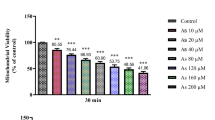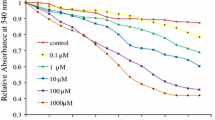Abstract
Oxidative damage has been implicated in disorders associated with abnormal copper metabolism and also Cu2+ overloading states. Besides, mitochondria are one of the most important targets for Cu2+, an essential redox transition metal, induced hepatotoxicity. In this study, we aimed to investigate the mitochondrial toxicity mechanisms on isolated rat liver mitochondria. Rat liver mitochondria in both in vivo and in vitro experiments were obtained by differential ultracentrifugation and the isolated liver mitochondria were then incubated with different concentrations of Cu2+. Our results showed that Cu2+ induced a concentration and time-dependent rise in mitochondrial ROS formation, lipid peroxidation, and mitochondrial membrane potential collapse before mitochondrial swelling ensued. Increased disturbance in oxidative phosphorylation was also shown by decreased ATP concentration and decreased ATP/ADP ratio in Cu2+-treated isolated mitochondria. In addition, collapse of mitochondrial membrane potential (MMP), mitochondrial swelling, and release of cytochrome c following of Cu2+ treatment were well inhibited by pretreatment of mitochondria with CsA and BHT. Our results showed that Cu2+ could interact with respiratory complexes (I, II, and IV). This suggests that Cu2+-induced liver toxicity is the result of metal’s disruptive effect on liver hepatocyte mitochondrial respiratory chain that is the obvious cause of Cu2+-induced ROS formation, lipid peroxidation, mitochondrial membrane potential decline, and cytochrome c expulsion which start cell death signaling.











Similar content being viewed by others
Abbreviations
- ROS:
-
Reactive oxygen species
- GSH:
-
Reduced glutathione
- DCFH-DA:
-
2′,7′-dichlorofluorescin diacetate
- TBARs:
-
Thiobarbituric acid reactive substances
- Cs A:
-
Cyclosporin A
- MDA:
-
Malondialdehyde
- Rh123:
-
Rhodamine 123
- BSA:
-
Bovine serum albumin
- MPT:
-
Mitochondrial permeability transition
- MMP:
-
Mitochondrial membrane potential
- BHT:
-
Butylated hydroxytoluene
- MTT:
-
3-(4,5-dimethylthiazol-2-yl)-2,5-diphenyltetrazolium bromide
- TTFA:
-
Thenoyltrifuoroacetone
- AA:
-
Antimycin A
- DTNB:
-
Dithiobis-2-nitrobenzoic acid
- Rot:
-
Rotenone
- DMSO:
-
Dimethyl sulfoxide
- TEP:
-
Tetramethoxypropane
References
Gaetke, L. M., & Chow, C. K. (2003). Copper toxicity, oxidative stress, and antioxidant nutrients. Toxicology, 189, 147–163.
Pourahmad, J., & O’Brien, P. J. (2000). Contrasting role of Na + ions in modulating Cu2 + or Cd2 + induced hepatocyte toxicity. Chemico-Biological Interactions, 126, 159–169.
Schilsky, M. L. (1996). Wilson’s disease: genetic basis of copper toxicity and natural history. Seminars in Liver Disease, 16(l), 83–95.
Britton, R. S. (1996). Metal-induced hepatotoxicity. Seminars in Liver Disease, 16, 3–12.
Pourahmad, J., & O’Brien, P. J. (2000). A comparison of hepatocyte cytotoxic mechanisms for Cu2+ and Cd2+. Toxicology, 143, 263–273.
Pourahmad, J., Mihajlovic, A., & O’Brien, P. J. (2001). Hepatocyte lysis induced by environmental metal toxins may involve apoptotic death signals initiated by mitochondrial injury. Advances in Experimental Medicine and Biology, 5002, 49–52.
Pourahmad, J., Ross, S., & O’Brien, P. J. (2001). Lysosomal involvement in hepatocyte cytotoxicity induced by Cu2+ but not Cd2+. Free Radical Biology and Medicine, 30, 89–97.
Winge, D. R., & Mehra, R. K. (1990). Host defenses against copper toxicity. International Review of Experimental Pathology, 31, 47–83.
Zhang, S. S. Z., Noordin, M. M., Rahman, S. O. A., & Haron, J. (2000). Effects of copper overload on hepatic lipid peroxidation and antioxidant defense in rats. Veterinary and Human Toxicology, 42, 261–264.
Mehta, R., Templeton, D. M., & O’Brien, P. J. (2006). Mitochondrial involvement in genetically determined transition metal toxicity II. Copper toxicity. Chemico-Biological Interactions, 163, 77–85.
Brewer, G. J. (2005). Anti-copper therapy against cancer and diseases of inflammation and fibrosis. Drug Discovery Today, 10, 1103–1109.
Arciello, M., Rotilio, G., & Rossi, L. (2005). Copper-dependent toxicity in SH-SY5Y neuroblastoma cells involves mitochondrial damage. Biochem and Biophysical Research Communications, 327, 454–459.
Kawakama, M., Inagawa, R., Hosokawa, T., Satio, T., & Kurasaki, M. (2008). Mechanism of apoptosis induced by copper in PC12 cells. Food and Chemical Toxicology, 46, 2157–2164.
Valko, M., Morris, H., & Cronin, M. T. (2005). Metals, toxicity and oxidative stress. Current Medicinal Chemistry, 12, 1161–1208.
Boveris, A., Musacco-Sebio, R., Ferrarotti, N., Saporito-Magriñá, C., Torti, H., Massot, F., et al. (2012). The acute toxicity of iron and copper: biomolecule oxidation and oxidative damage in rat liver. Journal of Inorganic Biochemistry, 116, 63–69.
Ghazi-khansari, M., Mohammadi-Bardbori, A., & Hosseini, M.-J. (2006). Using Janus Green B to study paraquat toxicity in rat liver mitochondria role of ACE inhibitors (Thiol and Nonthiol ACEi). Annals of the New York Academy of Sciences, 1090, 98–107.
Bradford, M. M. (1976). A rapid and sensitive method for the quantitation of microgram quantities of protein utilizing the principle of protein-dye binding. Analytical Biochemistry, 72, 248–254.
Gao, X., Zheng, C. Y., Yang, L., Tang, X. C., & Zhang, H. Y. (2009). Huperzine A protects isolated rat brain mitochondria against β-amyloid peptide. Free Radical Biology and Medicine, 46, 1454–1462.
Barja, G. (2002). The Quantitative Measurement of H2O2 Generation in Isolated Mitochondria. Journal of Bioenergetics and Biomembranes, 34, 227–233.
Zhao, Y., Ye, L., Liu, H., Xia, Q., Zhang, Y., Yang, X., et al. (2010). Vanadium compounds induced mitochondria permeability transition pore (MPT) opening related to oxidative stress. Journal of Inorganic Biochemistry, 104, 371–378.
Zhang, F., Xu, Z., Gao, J., Xu, B., & Deng, Y. (2008). In vitro effect of manganese chloride exposure on energy metabolism and oxidative damage of mitochondria isolated from rat brain. Environmental Toxicology and Pharmacology, 26, 232–236.
Sadegh, C., & Schreck, R. P. (2003). The spectroscopic determination of aqueous sulfite using Ellman’s reagent. MIT Undergraduate Research Journal, 8, 39–43.
Baracca, A., Sgarbi, G., Solaini, G., & Lenaz, G. (2003). Rhodamine 123 as a probe of mitochondrial membrane potential: evaluation of proton flux through F(0) during ATP synthesis. Biochimica et Biophysica Acta, 1606, 137–146.
Tafreshi, N. K., Hosseinkhani, S., Sadeghizadeh, M., Sadeghi, M., Ranjbar, B., & Naderi-Manesh, H. (2007). The influence of insertion of a critical residue (Arg356) in structure and bioluminescence spectra of firefly luciferase. Journal of Biological Chemistry, 282, 8641–8647.
Drew, B., & Leeuwenburgh, C. (2003). Method for measuring ATP production in isolated mitochondria: ATP production in brain and liver mitochondria of Fischer-344 rats with age and caloric restriction. American Journal of Physiology: Regulatory, Integrative and Comparative Physiology, 28, 1259–1268.
Belyaeva, E. A., Korotkov, S. M., & Saris, N. E. (2011). In vitro modulation of heavy metal-induced rat liver mitochondria dysfunction: a comparison of copper and mercury with cadmium. Journal of Trace Elements in Medicine and Biology, 25, 63–73.
White, A. R., Huang, X., Jobling, M. F., Barrow, C. J., Beyreuther, K., Masters, C. L., et al. (2001). Homocysteine potentiates copper- and amyloid beta peptide peptide-mediated toxicity in primary neuronal cultures: possible risk factors in the Alzheimer’s-type neurodegenerative pathways. Journal of Neurochemistry, 76, 1509–1520.
Goldfrank, L. R., Flomenbaum, F. E., & Lewin, N. A. (1998). Goldfrank’s toxicologic emergencies,6 (th ed., pp. 1339–1340). Stamford: Appleton and Lange.
Pourahmad, J., Stohs, S. J., & Bagchi, D. (1995). Oxidative mechanisms in the toxicity of metal ions. Free Radical Biology and Medicine, 18, 321–3685.
Pourahmad, J., Hosseini, M.-J., Bakan, S., & Ghazi-Khansari, M. (2011). Hepatoprotective activity of angiotensin-converting enzyme (ACE) inhibitors, captopril and enalapril, against paraquat toxicity. Pesticide Biochemistry and Physiology, 99, 105–110.
Belyaeva, E. A., Dymkowska, D., Wieckowski, M. R., & Wojtczak, L. (2008). Mitochondria as an important target in heavy metal toxicity in rat hepatoma AS30D cells. Toxicology and Applied Pharmacology, 231, 34–42.
Fattoretti, P., Vecchiet, J., Felzani, G., Gracciotti, N., Solazzi, M., Caselli, U., et al. (2001). Succinic dehydrogenase activity in human muscle mitochondria during aging: a quantitative cytochemical investigation. Mechanisms of Ageing and Development, 122, 1841–1848.
Nadanaciva, S., Bernal, A., Aggeler, R., Capaldi, R., & Will, Y. (2007). Target identification of drug induced mitochondrial toxicity using immunocapture based OXPHOS activity assays. Toxicology in Vitro, 21, 902–911.
Jones, T. T., & Brewer, G. J. (2010). Age-related deficiencies in complex I endogenous substrate availability and reserve capacity of complex IV in cortical neuron electron transport. Biochimica et Biophysica Acta, 1797, 167–176.
Seth, R., Yang, S., Choi, S., Sabean, M., & Roberts, E. A. (2004). In vitro assessment of copper-induced toxicity in the human hepatoma line, Hep G2. Toxicology in Vitro, 18, 501–509.
Zoratti, M., & Szabo, I. (1995). The mitochondrial permeability transition. Biochimica et Biophysica Acta, 1241, 139–176.
Krumschnabel, G., Manzl, C., Berger, C., & Hofer, B. (2005). Oxidative stress, mitochondrial permeability transition, and cell death in Cu-exposed trout hepatocytes. Toxicology and Applied Pharmacology, 209, 62–73.
Eguchi, Y., Shimizu, S., & Tsujimoto, Y. (1997). Intracellular ATP levels determine cell death fate by apoptosis or necrosis. Cancer Research, 57, 1835–1840.
Simmons, T. D., Slater, K. J., & Crouch, S. P. M. (2001). Changes in intracellular ADP:ATP ratio as a marker of apoptosis. Miami Nature Biotechnology-Winter Symposium, 1, 58.
Suzuki, S., Higuchi, M., Proske, R. J., Oridate, N., Hong, W. K., & Lotan, R. (1999). Implication of mitochondria-derived reactive oxygen species, cytochrome C and caspase-3 in N-(4-hydroxyphenyl) retinamide-induced apoptosis in cervical carcinoma cells. Oncogene, 18, 6380–6387.
Fortunato, F., Deng, X., Gates, L. K., McClain, C. J., Bimmler, D., Graf, R., et al. (2006). Pancreatic response to endotoxin after chronic alcohol exposure: switch from apoptosis to necrosis? American Journal of Physiology. Gastrointestinal and Liver Physiology, 290, 232–241.
Orrenius, S., Gogvadze, V., & Zhivotovsky, B. (2007). Mitochondrial oxidative stress: implications for cell death. Annual Review of Pharmacology and Toxicology, 47, 143–183.
Acknowledgments
The investigation described in this paper was extracted from Ph.D. thesis of Dr. Mir-Jamal Hosseini (graduated from Faculty of Pharmacy, Shahid Beheshti University of Medical Sciences in 2012). The thesis conducted under supervision of Prof. Jalal Pourahmad at Faculty of Pharmacy, Shahid Beheshti University of Medical Sciences, Tehran, Iran. This study was supported by a grant from Shahid Beheshti University of Medical Sciences, Deputy of Research (88-01-94-6677, 2011).
Author information
Authors and Affiliations
Corresponding author
Rights and permissions
About this article
Cite this article
Hosseini, MJ., Shaki, F., Ghazi-Khansari, M. et al. Toxicity of Copper on Isolated Liver Mitochondria: Impairment at Complexes I, II, and IV Leads to Increased ROS Production. Cell Biochem Biophys 70, 367–381 (2014). https://doi.org/10.1007/s12013-014-9922-7
Published:
Issue Date:
DOI: https://doi.org/10.1007/s12013-014-9922-7




